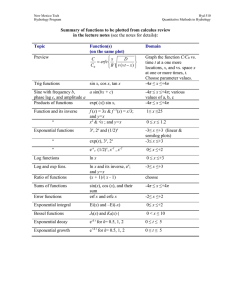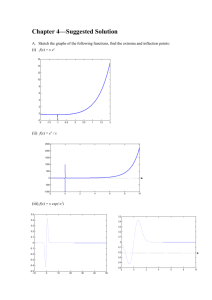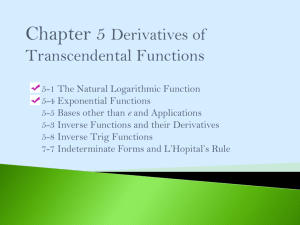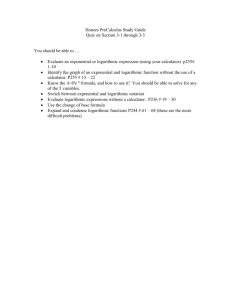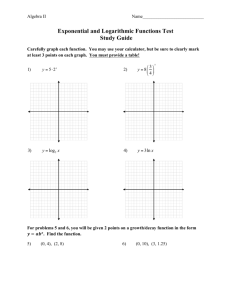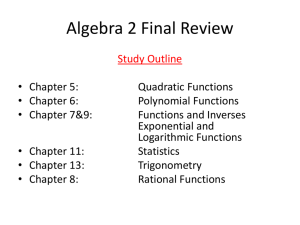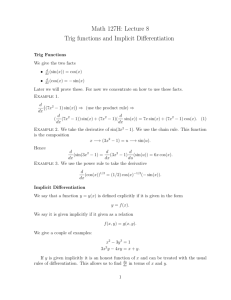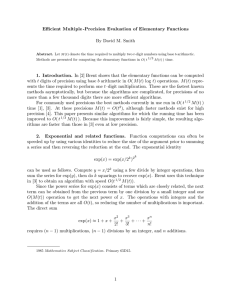calcu10Assign4
advertisement
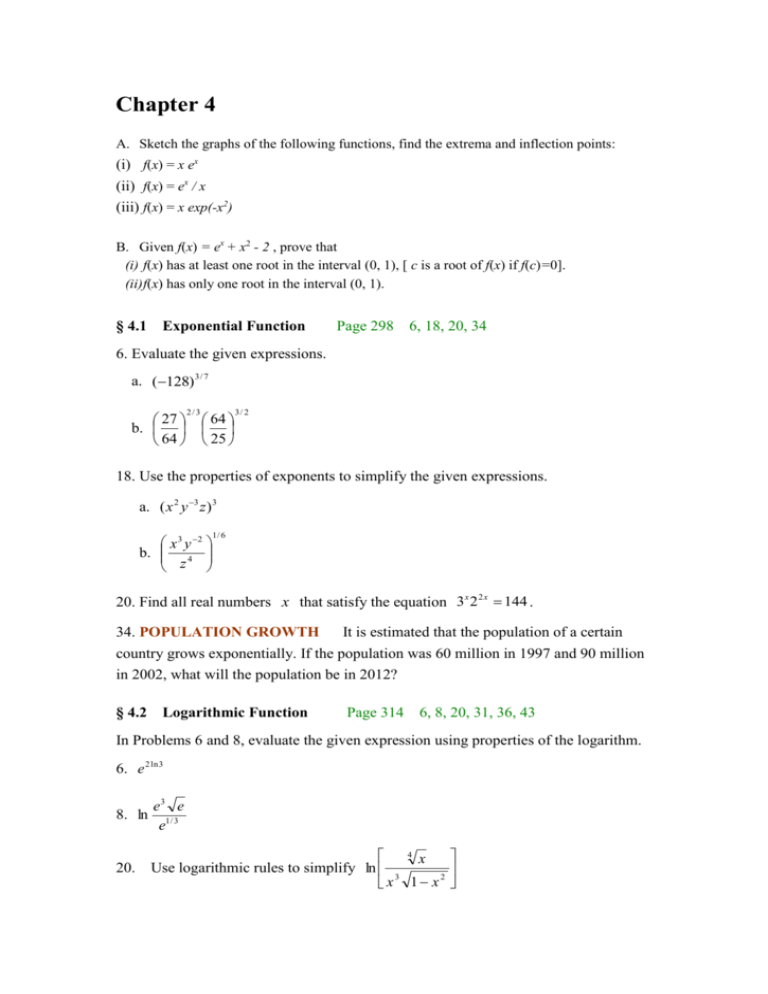
Chapter 4 A. Sketch the graphs of the following functions, find the extrema and inflection points: (i) f(x) = x ex (ii) f(x) = ex / x (iii) f(x) = x exp(-x2) B. Given f(x) = ex + x2 - 2 , prove that (i) f(x) has at least one root in the interval (0, 1), [ c is a root of f(x) if f(c)=0]. (ii) f(x) has only one root in the interval (0, 1). § 4.1 Exponential Function Page 298 6, 18, 20, 34 6. Evaluate the given expressions. a. (128)3 / 7 27 b. 64 2/3 64 25 3/ 2 18. Use the properties of exponents to simplify the given expressions. a. ( x 2 y 3 z )3 1/ 6 x 3 y 2 b. 4 z 20. Find all real numbers x that satisfy the equation 3 x 2 2 x 144 . 34. POPULATION GROWTH It is estimated that the population of a certain country grows exponentially. If the population was 60 million in 1997 and 90 million in 2002, what will the population be in 2012? § 4.2 Logarithmic Function Page 314 6, 8, 20, 31, 36, 43 In Problems 6 and 8, evaluate the given expression using properties of the logarithm. 6. e 2 ln 3 8. ln e3 e e1/ 3 4 x 20. Use logarithmic rules to simplify ln 3 2 x 1 x In Problems 31 and 36, solve the given equation for x. 1 31. ln x (ln 16 2 ln 2) 3 5 3 36. 1 2e x 43. COMPOUND INTEREST How quickly will money double if it is invested at an annual interest rate of 6% compounded continuously? § 4.3 Differentiation of Logarithmic and Exponential Function Page 330 7, 36, 55 7. Differentiate the functions: (i) f ( x) ( x 2 3x 5)e 6 x , (ii) ln(1+ x2) / [1 + exp(-x2)] (iii) (ex –e-x) / (ex + e-x) 36. Find the largest and smallest values of the function F ( x) e x 2 x over interval [0, 2]. 2 55. Given f ( x) 5 x , use the logarithmic differentiation to find the derivative f ' ( x) . 2 § 4.4 Additional Exponential Models Page342 25, 27, 38, 39 25. THE SPREAD OF AN EPIDEMIC Public health records indicate that t weeks after the outbreak of a certain form of influenza, approximately 2 f (t ) thousand people had caught the disease. 1 3e 0.8t a. Sketch the graph of f (t ) b. How many people had the disease initially? c. How many had caught the disease by the end of 3 weeks? d. If the trend continues, approximately how many people in all will contract the disease? 27. EFFICIENCY The daily output of a worker who has been on the job for t weeks is given by a function of the form Q(t ) 40 Ae kt . Initially the worker could produce 20 units a day, and after 1 week the worker can produce 30 units a day. How many units will the worker produce per day after 3 weeks? 39. Newton's law of cooling states that the temperature of a hot object will cool down to the temperature of its surrounding following an exponential decay. In symbols, if an object is at a temperature T at time t and the surrounding is at a constant temperature (e for external), then T can be expressed as a function of time t: T(t) = Te + (T0 – Te) exp(-kt). If a piece of steak leaves an oven at a temperature of 200oC in a room at 20oC. It cools to 100oC in 15 minutes. How long does it take to cool further from 100 oC to 40oC? § 4.5 Differentiation of Trigonometric and Exponential Function C. Differentiate the functions, where a & b are constants: (1) sin 2(ax) + cos 2(bx); (2)ex sin(ax); (3) (sin(ax) + cos(bx)) exp(-x2) ; (4)cos(ax) / (ex + e-x). § 4.6 Taylor Expansion D. Expand the following functions around x=0: (ii) sin(x) (i) ln(1+x), (iii) f ( x) x 2 2 x 3 (iv) f ( x) 3xe x 2 /2 E. Use the Taylor Expansion to evaluate the following: (i) ln(1.5); (ii) sin(30o). How many terms you need in order to achieve accuracy up to 3 decimal places.
